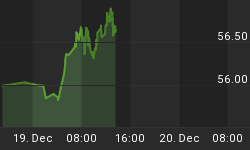The U.S. Dollar overcame early weakness to post a weekly closing price reversal bottom. This move doesn't turn the trend to up, but is a strong indication that the Dollar will rally for 2 to 3 weeks. A follow-through rally through .7734 next week is needed to confirm the reversal bottom. The main trend will turn up following a breakout over .7997.
To recap the market moving events this week, the Fed FOMC left interest rates at near historically low levels while deciding it was too early to pull out of is current stimulus plans. The Fed also said that the economy was improving especially in the housing and financial markets. The FOMC also decided to slow down its debt buying plan by extending its program to purchase mortgage-backed securities into the first quarter of 2010.
Traders at first drove the Dollar to new lows for the week on the news, but quickly reversed themselves to the upside before the close on Wednesday. Thursday's action showed more strength in the Dollar as Wednesday's daily chart reversal was confirmed. Friday, U.S. Durable Goods were reported weaker than expected. The Dollar gave back some of its gains on the news as this report indicated that the U.S. economic recovery would be slow and labored.
The EUR USD is in a position to form a weekly closing price reversal top following a close under 1.4710. The main trend on the daily chart is also set to reverse to the down side on a trade through 1.4611. Based on the current chart pattern, look for the start of a 2 to 3 week break with 1.4425 the next downside objective. Investors cite sluggishness in the U.S. economy as the main reason why demand for higher risk assets is set to decline.
The GBP USD is expected to finish near its weekly low. With the main trend down and downside momentum building, traders should start to anticipate further weakness to at least 1.5271 over the near term. Most of this week's break was triggered by bearish comments from Bank of England Governor Mervyn King who stated in an interview that he favored a weaker currency.
The weekly USD CAD chart indicates that a double-bottom may be forming at 1.6305 and 1.0589. This formation will be confirmed when the market trades through 1.1124. The main trend on the weekly chart will also turn up on this move. Based on the main range of 1.1124 to 1.1723, look for a retracement to 1.1156 to 1.1290. Fundamentally, weaker equity and crude oil prices should keep the pressure on the Canadian Dollar. The Canadian economy is likely to take a big hit if crude oil prices continue to weaken.
The USD CHF reached a new low for the year earlier this week on hopes of a stronger economic recovery in Switzerland. Late in the week, the Dollar began to rally versus the Swiss Franc. The current chart formation indicates the possibility of a weekly closing price reversal bottom. A close over 1.2092 will create the bottom but a follow-through rally will be needed next week to confirm it. The first upside objective is 1.0603 to 1.0702 if this reversal bottom is confirmed.
The USD JPY is expected to close near the low for the week. This week's strong Yen negated last week's closing price reversal bottom in the USD JPY. The charts now indicate the possibility of a break to the low for the year at .8711. Repatriation by Japanese exporters triggered the start of the weakness in the USD JPY, but it was bullish comments by the Japanese Finance Minister that fueled Friday's acceleration to the downside. Look for the Yen to continue to rally next week as the Japanese government seems to have no intention of intervening.
Demand for higher yielding assets dropped after the Fed FOMC meeting on September 23rd. The selling pressure hit the AUD USD harder than the NZD USD and now has the Aussie in a position to post a weekly closing price reversal top. A close under .8673 forms a weekly reversal. Based on the current weekly range of .8156 to .8788, look for a correction to .8472 to .8397 over the next 2 to 3 weeks. The New Zealand Dollar broke from the high for the week, but remained in a position to close higher.















